
It is no secret that I love a nature-based holiday, and I have been fortunate enough to visit some amazing wilderness locations around the world. When visiting America, I have still enjoyed visiting the big cities, like New York and Los Angeles, but where I think the USA really excels is their National Parks. Although I doubt that I will ever be able to visit them all, I have managed to tick off quite a few, and they have never disappointed.
In recent years, I have been lucky enough to spend some time in both Yosemite and Yellowstone, enabling me to make a direct comparison between two of America’s most famous National Parks. So, I believe I am in a good position to answer the inevitable question; Yosemite vs Yellowstone, which is best?
| Yosemite National Park | Yellowstone National Park | |
|---|---|---|
| Location | Northern California | Wyoming, Montana & Idaho |
| Nearest Towns | Fresno, Modesto | Boseman, Jackson |
| Size (square miles) | 1,200 | 3,400 |
| Annual Visitors | 3,830,000 | 4,860,000 |
| Year Designated | 1890 * | 1872 |
| Primary Geological Force | Glacial | Volcanic |
| Current Climate | Mediterranean | Sub-Arctic / Alpine |
| Elevation (feet above sea Level) | 2,100 – 13,100 | 5,300 – 11,300 |
| Iconic Landmarks | Half Dome, El Capitan | Old Faithful, Lamar Valley |
| Wildlife | Black Bear, Mule Deer, Coyote | Grizzly Bear, Bison, Wolf, Elk |
At the time of writing, there are 63 National Parks in the USA, although the National Park service look after more than 420 areas, these include national monuments and historic sites. With its wide-open areas and high mountain range, it should be no surprise that the majority of America’s National Parks are in the west of the country, with California home to the most of any American State.
Yosemite is one of California’s Great National Parks, and it is located in the northern Sierra Nevada Mountains.
Yellowstone National Park covers such a large area that it crosses the borders into three different American States. The vast majority of the park can be found in Wyoming, but smaller sections of the park spread into Montana and Idaho.
There are three main entrances to Yosemite National Park and most visitors to Yosemite will arrive by car. International visitors will often arrive into San Francisco, which is about 200 miles from the Western Entrance to the park.
Those not wishing to drive from San Francisco can also take a domestic flight to Fresno-Yosemite airport, which is about 65 miles from Yosemite’s Southern Entrance at Wawona.
Yosemite’s Eastern Entrance is approximately 35 miles from the town of Mammoth Lakes and Mammoth-Yosemite Airport. However, as this entrance requires access via the Tioga Pass, this route is only passable during the summer months.
It is possible to visit Yosemite National Park without a car. From cities like Fresno, Merced and Mariposa there is a scheduled bus service called the ‘Yosemite Area Regional Transport System’. Once inside the park, there is a free National Parks Service shuttle bus that operates throughout the Yosemite Valley.
For my Yosemite holiday, and because I wanted to explore beyond Yosemite Valley, I chose to rent a car and drive from San Francisco. The route is simple, and the park is well sign-posted on arrival.

There are five main entrances into Yellowstone National Park and most visitors will arrive by car or RV. There are no big cities close to Yellowstone, but towns such as West Yellowstone do lie on the park’s border.
Yellowstone’s West Entrance is about a mile outside of the town of West Yellowstone, and many visitors staying outside the park will stay here and use this entrance. It offers good access to ‘Old Faithful’ and the volcanic features in the area.
The town of Gardiner is close to the North Entrance, however visitors using this entrance are likely to have arrived at Bozeman which is 90 miles away. Bozeman has a domestic airport and is a popular starting point for those flying to Yellowstone. From the North Entrance, it is about 5 miles to Mammoth Hot Springs inside the park.
The Northeast Entrance has easier access from Cooke City and Silver Gate in Montana. This route arrives along the scenic Beartooth Highway and Lamar Valley, but it is only open during the summer months.
Similarly, the East Entrance is best for visitors approaching from the town of Cody, in Wyoming. This lesser used entrance is only open seasonally as it utilizes the Sylvan Pass.
Yellowstone’s Southern Entrance is about 60 miles from the town of Jackson, Wyoming, which is home to Jackson Hole airport. This makes it a very popular gateway for visitors to Yellowstone. Not only that, but Jackson is just 12 miles from Grand Teton National Park, so visitors will often combine visits to both National Parks.
Unlike Yosemite, Yellowstone National Park does not offer a bus service within the park. It is possible to join a private tour to see certain areas of the park, but to really explore Yellowstone a private vehicle is recommended.
For my Yellowstone holiday I flew to Jackson Hole from Atlanta and rented a car to visit both Grand Teton National Park and Yellowstone National Parks. During the summer months it takes around 90 minutes to reach the South Entrance from Jackson (depending on traffic), which is a good entrance point for visiting Grant Village and Yellowstone Lake.
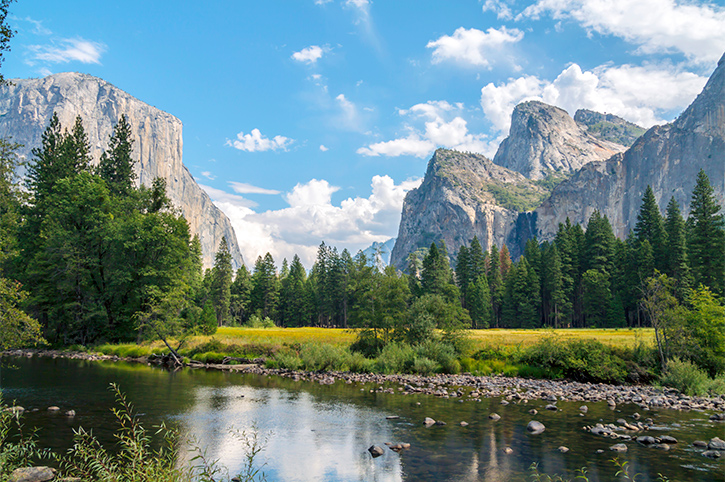
Being relatively high in the Northern Hemisphere, both Yosemite and Yellowstone experience quite dramatic differences between the seasons. In particular, during the winter months, access to both parks can be restricted, so it is important to understand the expected conditions at each park and plan your visit accordingly.
It may surprise you to learn that Yosemite National Park is a year-round destination. Although most people will choose the summer months to visit, it is possible to access some areas throughout the year.
Spring (March to May): Spring is a magical time in Yosemite when the dramatic waterfalls are at their peak, and the meadows burst into vibrant wildflower displays. The weather is generally mild, but some areas may still have snow, especially at higher elevations.
Summer (June to August): Summer is the most popular time to visit, with warm days and clear skies. This is when the park’s high-country trails and attractions are accessible. However, it’s also the busiest season, so be prepared for crowds and make accommodation reservations well in advance.
Autumn (September to November): America’s Fall is a fantastic time to visit, with cooler temperatures, fewer crowds, and the park’s foliage changing into vibrant autumn colours.
Winter (December to February): While many park roads and facilities close in winter, Yosemite’s lower elevations remain accessible. It’s a serene time to experience the park’s quieter side and see the waterfalls framed by ice.
I visited in early autumn, just as the crowds began to reduce, but still struggled with accommodation near the park, despite booking early. The roads were busy in the Yosemite Valley, but clearer further out. The waterfalls were limited as it had been a dry summer, so you will need to come early to see them in full flow.
Yellowstone is further north than Yosemite National Park and so it experiences greater extremes in temperatures and weather during the winter months. This gives Yellowstone a more alpine environment that is able to endure more extreme winters.
Spring (April to June): The weather can still be unpredictable Spring so some roads and facilities may remain closed, However, it is an excellent time for quiet exploration and waterfalls will be at their fullest, whilst the local wildlife will be nursing newborns.
Summer (June to August): Summer is the peak season in Yellowstone, with warm temperatures and most roads and facilities accessible. This is the best time for wildlife viewing, as animals are active, and it’s also perfect for outdoor activities such as hiking, camping, and boating. However, expect crowds at the most popular locations, so plan your trip well in advance.
Autumn (September to October): This is a magical time in Yellowstone, with cooler temperatures, fewer visitors, and stunning autumn colours. It is a prime time for wildlife enthusiasts, as the park’s famous elk rut takes place. Roads remain open, though some services start to close as the season progresses.
Winter (November to March): Winter transforms Yellowstone into a snow-covered wonderland, so most roads and accommodations are closed. The National Parks Service does offer some unique guided experiences using special vehicles which give the opportunity to track wolves and witness geysers steaming in the cold.
I had to book very early to stay inside Yellowstone National Park during the summer. By staying inside the park I was able to take advantage of the quiet times of day, before the day trippers arrived, and after the crowds have gone, to see some of the most popular sites.
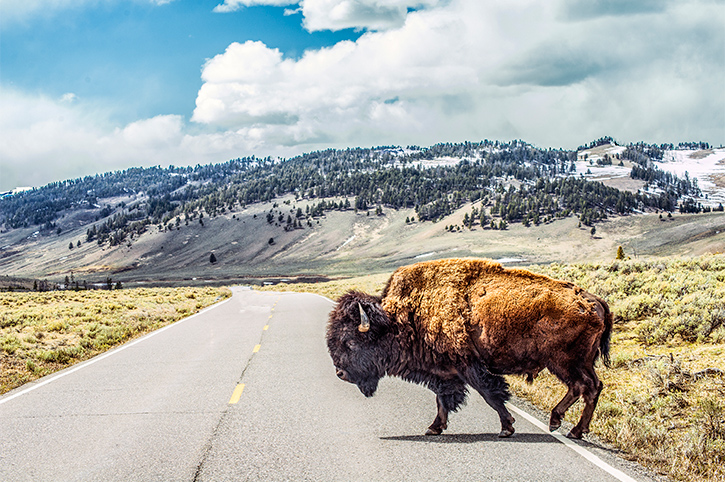
When deciding on visiting any National Park, it is important to do some research and understand the scenery and terrain that you will be exploring. Not only will this help determine which parks to visit but also what clothing and equipment to take with you. Although Yosemite and Yellowstone are often mentioned in the same breath, they have very different features, landscapes and wildlife.
Yosemite Valley: This lush valley is the beating heart of the park and is surrounded by the towering granite cliffs of famous landmarks like El Capitan and Half Dome.
Waterfalls: Yosemite is home to numerous waterfalls, including Yosemite Falls, Bridal Veil Falls, and Vernal Falls. They are both powerful and picturesque, particularly in the spring months.
Giant Sequoias: Mariposa Grove, in particular, is known for its ancient Giant Sequoia Redwoods. These massive trees are some of the largest and oldest living organisms on Earth.
Half Dome: This iconic granite monolith is a challenging hiking and rock-climbing destination, offering thrilling panoramic views from its summit. The hike is suitable only for experienced hikers.
Glacier Point: Accessible in the summer months, Glacier Point offers a spectacular panoramic view of the park, including the High Sierra peaks and the famous Half Dome.
Wildlife: Yosemite is home to black bears, mule deer, bobcats, and coyotes. The opportunity to observe these animals in their natural habitat is a unique and unforgettable experience.
Wildflowers: In the spring and early summer, the park comes alive with vibrant wildflowers. The meadows in the valley burst into a riot of colours.
Night Skies: Yosemite is designated as a Dark Sky Park, making it a superb location for stargazing. The unpolluted night skies reveal a breathtaking celestial display.
Holidays to Yosemite and Yellowstone from Freedom Destinations.
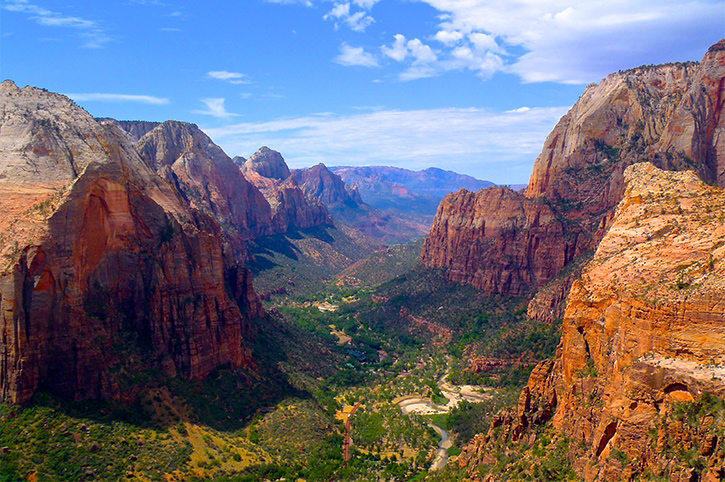
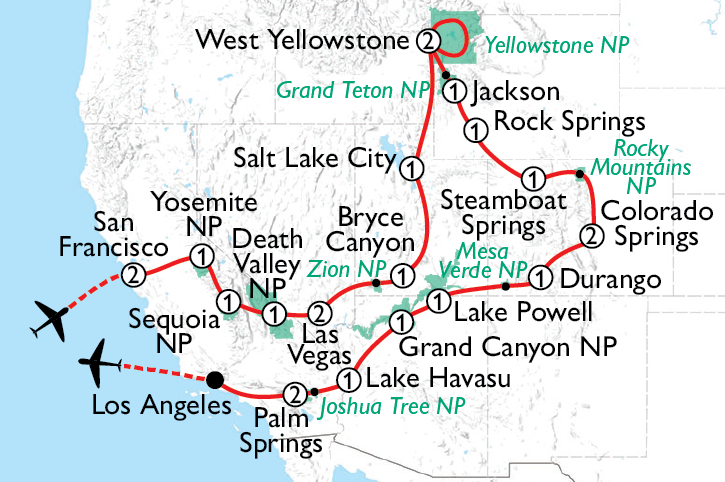
San Francisco | Yosemite | Sequoia | Death Valley | Zion | Bryce Canyon | Yellowstone | Grand Teton | Rocky Mountains | Mesa Verde | Grand Canyon | Joshua Tree


Las Vegas | Mammoth Lakes | Yosemite | Kings Canyon | Sequoia National Park | Los Angeles
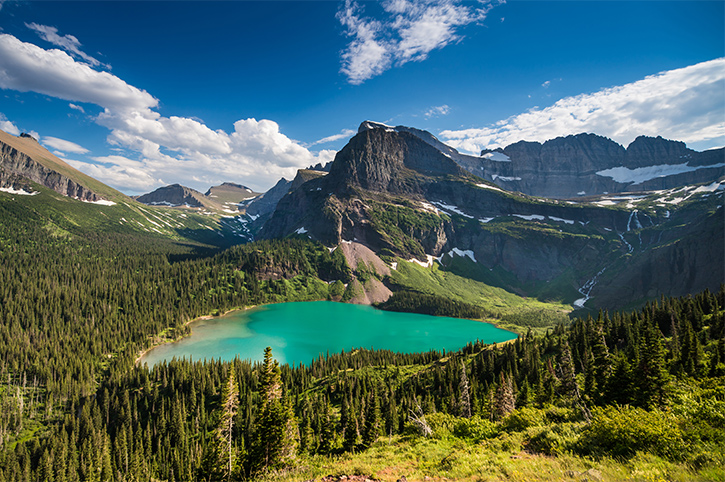

Seattle | Vancouver | Jasper | Banff | Calgary | Glacier National Park | Yellowstone | Grand Teton | Twin Falls | Mount Rainier | Yakima


San Francisco | Yosemite | Sequoia | Death Valley | Zion | Bryce Canyon | Yellowstone | Grand Teton | Rocky Mountains | Mesa Verde | Grand Canyon | Joshua Tree


Las Vegas | Mammoth Lakes | Yosemite | Kings Canyon | Sequoia National Park | Los Angeles


Seattle | Vancouver | Jasper | Banff | Calgary | Glacier National Park | Yellowstone | Grand Teton | Twin Falls | Mount Rainier | Yakima
Geysers and Hot Springs: Yellowstone is home to the world’s most famous geyser, ‘Old Faithful’, and over 10,000 other geothermal features. These natural wonders, including the Grand Prismatic Spring, offer mesmerizing displays of steam, water, and vibrant colours.
Grand Canyon of the Yellowstone: This impressive canyon features the iconic Lower and Upper Falls of the Yellowstone River. The vivid, multi-hued walls and thundering waterfalls are just a short walk from the road.
Wildlife: Yellowstone is renowned for its diverse wildlife, including Bison, Grizzly Bears, Wolves, and Elk. The park offers one of the best opportunities to see all of these animals in their natural habitat.
Yellowstone Lake: As the largest high-altitude lake in North America, Yellowstone Lake is a serene expanse of water surrounded by thermal features.
Norris Geyser Basin: Known for its dynamic geothermal activity, Norris Geyser Basin features bubbling mud pots, colourful hot springs, and impressive geysers, such as Steamboat Geyser.
Hayden Valley: This expansive valley is a prime location for spotting wildlife, particularly Bison, Elk, and Bears. Its lush meadows attract all the hungry wildlife.
Mammoth Hot Springs: These terraced hot springs create otherworldly formations that change over time, thanks to the constant flow of hot water and mineral deposits.
Lamar Valley: This area has been referred to as the “Serengeti of North America”. Lamar Valley is a prime location for wildlife viewing, especially Wolf packs and large Bison herds.
Hopefully by now you should have an understanding of the similarities and differences of these famous National Parks. In an ideal world I would recommend that you visit both Yosemite and Yellowstone, but understandably you may not be able to visit both in just one trip. So, which should you visit first?

Whilst I was hiking up to Glacier Point in Yosemite National Park a large Black Bear crossed the trail about ten metres ahead of me. He glanced in my general direction and then headed off down the slope as I tried to get my breath back.
In Yellowstone I took advantage of the opportunity to join a local guide for a day. I had already seen herds of Bison by the road and Elk out the back of my lodging, but my guide was able to take me to view Wolf dens, Moose wading through a lake, and Grizzly Bear mothers with cubs playing in the long grass.
These are just a few of my personal experiences to show that wildlife is prevalent in both parks. However, it seems, particularly in recent years, the human activity in Yosemite Valley has pushed much of the local wildlife further away into the higher altitudes where they are less likely to be disturbed. On the other hand, the herds of Bison in Yellowstone aren’t bothered by traffic, and cross the road whenever they want, usually causing a unique Yellowstone traffic jam. For me, Yellowstone National Park is the best for a variety of wildlife experiences.
Yosemite packs a lot of scenery into a relatively small area. It really does have that ‘wow factor’. High mountains lead through steep cliffs, to forested slopes and grass filled valleys. Every bend in the road reveals a new vista that you will not have seen before. I spent a lot of time sitting in Yosemite Valley, just looking up at ‘El Capitan’ wondering how anyone would attempt to climb it, only to realise that the small dots half-way up the sheer rockface were climbers I had met earlier in the car park.
Yellowstone is vast, with a dramatic diversity in landscapes. If you want gushing rivers and canyons Yellowstone has it. If you want giant swathes of forested hills, Yellowstone has it. If you want geothermal features in the foreground, Yellowstone has it. If you want snow-capped mountains in the background, well Yellowstone has it all. The size of Yellowstone is a double-edged sword. Yellowstone probably contains a bit of everything you can imagine, but I just don’t know because I haven’t seen it all. Not even a fraction of it. So, if you want your breathtaking scenery in just one visit, Yosemite is the winner.

As I have already indicated I did put my boots on and followed some of the trails in both Yosemite and Yellowstone. I am only an amateur when it comes to trail-walking, so I stuck to moderate routes and usually spent no-more than half a day stomping through the undergrowth.
In Yosemite the views at the top of the trails were stunning. There can be nothing more rewarding than hiking (past the bear!) to Glacier Point, to be rewarded with the spectacular views of Half Dome in front of you. It would have been breathtaking if I had any breath left!
The four-mile Elephant Back Trail in Yellowstone took me high above Yellowstone Lake, with panoramic views down to the water and the bright yellow, Yellowstone Lake Hotel. I was out early in the morning, so the trail was practically deserted, and the birdsong was mesmerizing. Weeks later, I learned that a hiker on the same trail, surprised a mother Grizzly and her cubs that were passing through. The result is a sad reminder that you should always make noise and carry bear spray when out in the wilderness.
As for which is best for hiking. I will have to sit on the fence here, and say that for day hikes with remarkable scenery, then Yosemite is perfect. However, for multi-day hikes through miles of untouched nature, then Yellowstone will be hugely rewarding.

Having travelled to both parks either on my own, or alongside my wife, I will readily admit that I am not the most experienced to answer this one. However, I did see families enjoying both parks, so I will base this on that anecdotal evidence.
Yosemite National Park is all about ‘shock and awe’. It is all about the scenery, and it is spectacular. However, in my experience, children can be less enthusiastic about a view then I am, and they also have a shorter attention span (although my wife may disagree). In Yosemite I saw children with their backs to an amazing view, whilst they looked at their phones, or asked when it was time to go back to the car. For me that is heartbreaking.
In Yellowstone I witnessed a family make their way around the park in a large RV. For a while I was in the car behind them, so I found myself stopping at the same viewpoints. The children appeared to love smelling the Sulphur around the mud pools and screamed with joy as the Bison walked past their vehicle. I even joined a guided ranger walk late one afternoon to find the family on that as well, and they were hanging on every word of the ranger’s stories as we followed the trail. Just for the sheer variety of experiences available, I think Yellowstone wins this time.

I am not a photographer, but some of my photos do hang on the walls at home, so I do take a proper camera (not just my phone) whenever I go away. If nothing else, when you want to take a good photo of moving wildlife, then you are going to require some proper equipment.
Yosemite’s scenery is constantly changing with the light. From the soft light of dawn, through the passing clouds of the day, through to the sun setting behind the mountains, nothing stays the same. Yosemite is oddly atmospheric. This is underlined by a visit to the Ansel Adams Gallery in Yosemite. For photography enthusiasts, this gallery showcases the works of the renowned photographer who captured the park’s mystery in his black-and-white images.
Yellowstone’s Grand Prismatic Springs is too colourful to describe here. It is truly stunning. However, I found when I got home, that my images didn’t really do it justice. The swirling steam washed out the colours, and nothing quite looked as I remembered. Had I had a drone to fly over the top, I think my images would have been a bit different. ‘Old Faithful’ is iconic and well worth stopping by to witness an eruption every 90 minutes. My only disappointment was that because it is so popular I always had someone in the crowd behind it. I prefer my nature natural, so I found that some of the other nearby geysers, away from the coach parties gave better results.
Whilst my photography cannot compare with Ansel Adams, I would still recommend Yosemite for the photography enthusiasts amongst you.
Unless you are lucky enough to be a Park Ranger, or just happen to live near to a park entrance, then planning your visit to either Yosemite or Yellowstone is crucial. By definition, National Parks are remote wilderness areas, so there is not an abundance of hotel accommodation within or close to the park. However, because they are remote wilderness areas, people travel from all over the world just to spend time there.

Accommodation inside America’s National Parks is usually rustic. Expect comfortable and dry lodgings, but don’t expect Wi-Fi, satellite TV, or luxury. The entertainment is outside, not in your room. Quite often these are old or historic buildings, probably well-used and little has changed over the last few decades. Most importantly, everything from camping, self-catering chalets to heritage hotels is hugely in demand and sell out months in advance. In fact, to get a choice of where you prefer to stay, you may need to start looking a year in advance.
Staying outside the National Parks is equally popular. Hotels within an hour’s drive of the gates to either Yosemite or Yellowstone is going to be in high demand, so will still need to book early.
Planning a holiday to Yosemite or Yellowstone should be part of the fun. However, it can be tricky. To help you out, Freedom Destinations’ expert America team are available to help you out. Whether you require help with accommodation or a holiday to Yellowstone or Yosemite, then give them a call. They can even plan a whole itinerary around visiting a few of America’s National Parks.
Richard has more than 25 years of experience working within the travel industry. He has travelled widely in Europe, the USA & Canada, Australia & New Zealand, South East Asia, as well as Southern Africa. He enjoys exploring National Parks and other wilderness areas.